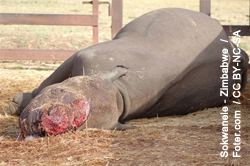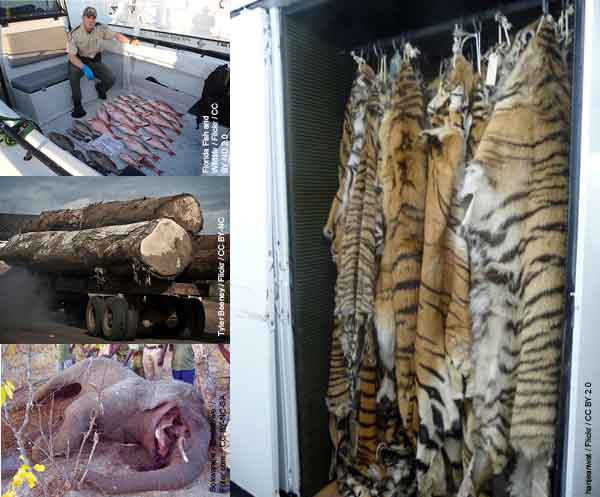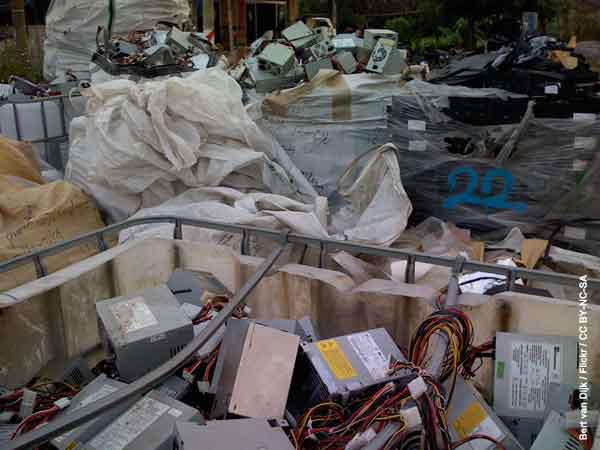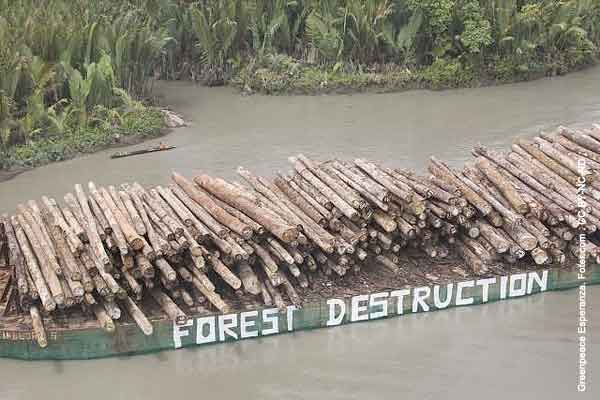|
Having trouble reading this email?
Download the PDF.

Thematic Focus: Environmental governance
Transnational Environmental Crime - a common crime in need of better enforcement
Why is this issue important?
Environmental crime typically refers to any breach of a national or international environmental law
or convention that exists to ensure the conservation and sustainability of the world's environment
(Elliot, 2007). Five areas are considered to be of major importance: illegal trade in wildlife;
illegal logging and its associated timber trade; illegal, unreported and unregulated (IUU) fishing;
illegal trade in controlled chemicals (including ozone-depleting substances); and illegal disposal of
hazardous waste. New types of environmental crime are also emerging, for example in carbon
trade and water management (INTERPOL, 2012).
|

|
The impacts of illegal trade can be wide-ranging, varying between countries and sectors:
- Illegal logging contributes to deforestation, deprives forest communities of vital livelihoods,
causes ecological problems such as flooding and is a major contributor to climate change.
- Illicit trade in ozone depleting substances contributes to a thinning ozone layer, which causes
human health problems such as skin cancer and cataracts.
- Illegal fishing leads to direct losses (Gross national product (GNP), foregone revenue); indirect
economic losses (income and employment in fisheries and other industries and activities in the supply chain);
environmental impacts (unsustainable impacts on target species and the ecosystem itself); and socio-economic
impacts (reduction in livelihood and food security) (Agnew, et al., 2010).
- Soil and water contamination from illegal hazardous waste dumping can damage ecosystems and human
health and illegal trade undermines the legitimate waste treatment and disposal industries.
- Poaching may have the greatest impact on species survival. For example, rhino, tiger and elephant
populations are today threatened with extinction due to poaching and illegal trade driven by growing
demand, in particular from Southeast Asia and China (OECD, 2012).
Some of the consequences of environmental crime are irreversible. The economic, environmental and
health impacts of illegal trade can be sufficiently important to disrupt whole economies and ecosystems,
undermining legal and environmentally sustainable activities and reducing future options for the use of
resources. There can be spillover effects, with indirect consequences. For instance, in fragile states
illegal trade can undermine the rule of law and can fuel armed conflict. Any serious attempt to tackle
illegal trade in environmental goods would benefit from a systematic evaluation of the impacts (OECD, 2012).

Dimensions of environmental crime
Though data are scarce and experts are constantly debating the relative merits and weaknesses of every new
study, the numbers reflect the potential for huge profits which is the fundamental driver of criminal trade
(Haken, 2011). In its report 'Transnational Crime in the Developing World', the non-governmental research and
advocacy body "Global Financial Integrity" made an estimate of the economic dimensions of transnational crime
(Haken, 2011). According to this report, illicit markets for wildlife, timber and fish ranked 5th, 6th and 7th
respectively in 2009. Havocscope is a private website which collates information and data on black markets for
a wide range of products from various open sources. While estimates between the two vary, as shown in Table 1,
both have ranked environmental crime in the top ten.

Table 1. Rankings for various illicit markets (Haken, 2011;Havocscope, 2012).
Full Size Image
Groups involved in environmental crime
Driven by perceptions of low risk and high profit, indications have emerged of environmental crime
activities attracting the greater interest of organized crime groups. Organized criminal syndicates are
moving poached or illegally harvested wildlife with the help of the same sophisticated techniques and
networks used for illicit trafficking in persons, weapons, drugs and other contraband (Scanlon, 2012).
Groups specializing in money laundering, financial crime, thefts and drug trafficking in European Union
(EU) Member States are now engaged in environmental crime as well. In general, however, substantial
intelligence gaps preclude a comprehensive assessment of organized crime activity in this area (Europol, 2011).
Many of the benefits of globalization, such as easier and faster communication, the movement of
finances and international travel, are used by criminal groups to carry out criminal activities. The
Internet is used with increasing sophistication to facilitate trade (Europol, 2011).
Results of a research conducted by the UN Office on Drugs and Crime (UNODC) on various forms of environmental
crime in Southeast Asia suggest that the criminal networks responsible for wildlife and timber trafficking, as
well as the smuggling of e-waste and ozone depleting substances, use sophisticated techniques and operate
between continents in order to connect cheap supply sources to wealthy markets (UNODC, 2012a).
UNODC, the Governments of Italy and Colombia and the International Criminal Police Organization
(INTERPOL) decided in 2010 to jointly develop a Digest of Organized Crime Cases to provide States with a
compilation of cases on organized crime accompanied by expert commentary and related good practices
(UNODC, 2012b). In one Brazilian case concerning illicit logging in the Amazon Rainforest, the expert
stated that the role of the corrupt officials and the professionals (e.g. engineers, topographic experts
and other experts) who conspired in the issuance of the authorizations was not confined to mere facilitators
in the fraudulent activities. On the contrary, since they were actively pursuing their own personal interests,
they were one of the "motors" of the entire criminal scheme, promoting it just as much as the other participants,
including the landowners, sawmill owners, transporters and licensed managers of the Forest Projects. The
Brazilian expert also noted that environmental crimes are a significant new form of organized criminal activity
alongside traditional activities such as drug trafficking.
The criminal conduct in the four cases on environmental crime mentioned in the study adheres to the same
structure as in traditional organized crime cases, including a "business model" and the use of modern
technologies. The groups' high level of organization requires law enforcement agencies to dedicate significant
time and human, financial and technological resources to combat their criminal activities (UNODC, 2012b).
The specific Italian cases of illicit disposal of hazardous or normal waste mentioned in the 2009 report of
the Italian National Anti-mafia Directorate involved fraudulent authorizations, which were frequently issued by
corrupt officials (UNODC, 2012b). Europol (2011) found that illicit waste trafficking is often facilitated by
cooperation with legitimate businesses, including those in the financial services, import/export and metal
recycling sectors, and with specialists engaged in document forgery for the acquisition of permits. Lack of
harmonization concerning the distinction between waste and second hand goods has resulted in e-waste
(second-hand electrical and electronic equipment) and deregistered vehicles in particular being shipped to
non-Organisation for Economic Co-operation and Development (OECD) and other states.

Electronic waste
Illegal activities flourish when appropriate governance and regulation is lacking, including failures
to determine or protect property rights (open access problems), inappropriate or weak regulation and
corruption (OECD, 2012). A specific case in point is waste. In addition to the challenges of monitoring
and detecting criminal conduct, there are varying definitions or understandings from country to country
of what constitutes 'waste', 'hazardous waste' and 'illegal shipments' of hazardous waste. To make things
even worse, most developing countries apparently lack an adequate legal framework enabling them to
effectively define, prevent and combat illegal traffic (SBC, 2012).
In general, criminal penalties for environmental crimes are relatively light. Important offences
risk being excluded from the categories of organized or serious crimes for which reinforced legal
tools and law enforcement resources are usually provided (UNODC, 2012b). In international environmental
law, little or no reference is made to sanctions themselves. In cases where provisions concern potential
violations of norms or standards, a simple reference can be found to the obligation to punish. Only the
Convention on the Law of the Sea prescribes, for a specific type of violation, the application of
monetary penalties (ISISC, 2010).
What are the implications for policy?
In 2000 and 2003 respectively, UNODC adopted the UN Convention on Transnational Crime (UNTOC) and
the United Nations Convention Against Corruption (UNCAC). These are two important instruments have
started drawing attention to the link between environmental crime and corruption. However, resolutions
adopted by these treaties only focus on wildlife, timber and forest products, with reference to the
Convention on International Trade in Endangered Species of Wild Fauna and Flora (CITES) and the
Convention on Biological Diversity (CBD). The resolutions are contained in the UN Economic and
Social Council (ECOSOC) resolutions 2001/12 (ECOSOC, 2001), 2008/25 (ECOSOC, 2008), and 2011/36
(ECOSOC, 2011); and resolution 16/1 (UNODC, 2007) and resolution 20/5 (UNODC, 2011) of the
Commission on Crime Prevention and Criminal Justice (CCPCJ).
The fact that wildlife and forest products are explicitly mentioned can be credited to the very
active role of the CITES Secretariat to raise awareness of this issue at an international level,
including through the creation of the International Consortium on Combating Wildlife Crime (ICCWC) –
comprising CITES, INTERPOL, UNODC, the World Bank and the World Customs Organization (WCO).
The Financial Action Task Force (FATF) is an inter-governmental body established in 1989 by the Ministers
of its Member jurisdictions. The objectives of the FATF are to set standards and promote effective
implementation of legal, regulatory and operational measures for combating money laundering, terrorist
financing and other related threats to the integrity of the international financial system. Under the
FATF 40 Recommendations (FATF, 2003), the FATF has included environmental crime in the "Designated
Categories of Offences" as a predicate offence to money laundering.
Cooperation is taking place between intergovernmental organizations such as UNEP, UNODC, INTERPOL,
WCO, CITES and the World Bank, and through the International Consortium on Combating Wildlife Crime (ICCWC).
Other partners and environmental Non-Governmental Organisations (NGOs) such as the International Network
for Environmental Compliance and Enforcement (INECE), the Environmental Investigation Agency (EIA) and
TRAFFIC are also assisting governments in combating environmental crime.
The INTERPOL General Assembly Resolution AG-2010-RES-03 states that "there is a vital need
for a global response to combating environmental crime and INTERPOL should play a leading
role in supporting the international enforcement efforts" (INTERPOL General Assembly, 2010).
INTERPOL projects offer an interesting perspective on the various areas where criminal law can
intervene to protect the environment. These include Project Predator (wild tigers), Project Wisdom
(elephants and rhinoceros), Project Leaf (illegal logging and other forest crime) led by INTERPOL and
UNEP; and Project Clean (illegal discharge of waste from vessels). A project on Pollution Crime
Forensics aims at creating a network of environmental technical and forensic experts, promoting best
practices in environmental forensics and compiling them in a manual for distribution. A project on Global
E-Waste is intended to design and execute an intelligence-led global analysis of the links between
organized crime and the illegal export of e-waste. INTERPOL officially launched its National
Environmental Security Task Force (NEST) initiative at the 21st INTERPOL Asian Regional Conference in
September 2012. The initiative will establish a common platform and approach worldwide for national
compliance and enforcement responses, so as to enhance both national and international efforts on
ensuring current and future environmental security.
The World Customs Organization (WCO) continues to work closely with other international
organizations involved in environmental issues such as the CITES Secretariat, the Basel
Convention Secretariat and UNEP, which maximises joint efforts in the fight against environmental
crime (WCO, 2009). Since 2001, the WCO has been an active partner in the Green Customs Initiatives,
which is a series of collaborative activities by UNEP, WCO and a number of Multilateral Environmental
Agreements (MEAs) to raise awareness to Customs officers about environment crime.
UNODC assists Governments to fight corruption, strengthen law enforcement and support sustainable
livelihoods. Most of the initiatives, however, suffer from a lack of donor awareness regarding the
magnitude of the problem, and consequently lack adequate funding (UNODC, 2012c).
The concept of intelligence-led enforcement, alongside preventative policing, is gradually
being embraced and recent commitments in India and by the international community suggests that
a new era of wildlife crime enforcement is being ushered in. The Wildlife Crime Control Bureau
(WCCB) of India has collaborated with NGO specialists to deliver actionable intelligence to local
forces resulting in seizures, arrests and the disruption of criminal networks at a domestic level (EIA, 2008).
There are signs that consumer markets are finally waking up to the role that demand plays in driving
illegal logging. In May 2008, the US Congress amended the 1900 Lacey Act (for the protection of both plants
and wildlife through civil and criminal penalties for a wide array of violations) and agreed on a landmark new
law that allows prosecutions for violations of foreign law. The amendment makes it an offence to import or sell
illegally-harvested timber and wood products in the USA.

The European Parliament and European Council have
approved a legislation reflected in the Forest Law Enforcement, Governance and Trade (FLEGT) Action Plan of the
European Union. The legislation prohibits the sale of timber logged illegally under the rules of the country of
origin. In addition, companies must use a system of 'due diligence' to ascertain that the timber they sell
in the EU was harvested legally. The Illegal Logging Prohibition Act 2012 in Australia promotes the purchase
and sale of legally logged timber products in Australia and gives consumers and businesses greater certainty
about the legality of the timber products they buy.
The political declaration from the Twelfth United Nations Congress on Crime Prevention and Criminal
Justice, referred to as "Salvador Declaration on Comprehensive Strategies for Global Challenges",
acknowledged the challenge posed by emerging forms of crime that have a significant impact on the environment
(UN General Assembly, 2010). It encourages Member States to strengthen their national crime prevention and
criminal justice legislation, policies and practices in this area and to enhance international cooperation,
technical assistance and the sharing of best practices.
What can be done?
In fighting environmental crimes, a strong regulatory regime and effective prevention mechanisms,
including anti-corruption measures, may be just as important as criminal law tools. Environmental crime is
a haven for corruption at all levels and unless corrupt officials are tackled efforts to combat environmental
crime will be impeded - a fact that should be acknowledged within cross-cutting resolutions on environmental
crime within the United Nations and within the UN Convention against Corruption (EIA, 2008).
Because of often thematic policy-making at international level, criminal accountability for environmental
harms derives from a wide array of norms scattered among a diverse set of treaties that often impose
differing, sometimes obscure, standards of protection. For environmental crimes, international criminal
law conventions (or a single convention) could be conceived in order to have comparable obligations of
criminalization and an extension of criminal jurisdictions ensuring that no safe havens remain for the offenders (ISISC, 2010).
More systematic accounting for the hidden costs of transnational environmental crime, for
example loss of current and future revenue resulting from degradation of ecosystem services, or the
social and economic costs of floods resulting from extensive illegal logging, as well as the increasingly
organized nature of such illegal activities, would help to raise the criminal profile of transnational
environmental crimes over their purely environmental dimension.
The EIA stresses the need to encourage the application of existing national criminal laws, proceeds
of crime and seizure of assets legislation against environmental criminals in addition to "environmental specific"
legislation (EIA, 2008). Administrative reform, particularly through the introduction of technology to remove
direct human contact involved in areas such as trade in natural resources, would be another way to combat corruption (EIA, 2008).
International cooperation
Considering the possibility of establishing international jurisdiction for international environmental
offences, it is important to reflect on the cooperation of States with the international bodies (ISISC, 2010).
One way is to participate in existing international, national and regional environmental crime enforcement
units and border liaison offices that would share intelligence with each other in order to develop
investigations and operations targeting criminal networks (EIA, 2008). A more coordinated approach where
all forms of environmental crime are considered on the same level of importance, and are integrated
in action plans on money laundering and organized transnational crime, is necessary in future.
Acknowledgement
Written by: Ludgarde Coppensa.
Reviewed by: Ron Wittb, Djaheezah Subrattyc and Neeyati Patela
Production and Outreach Team:Arshia Chanderd, Erick Litswaa,
Kim Giesed, Michelle Anthonyd, Reza Hussaind, Theuri Mwangia
and Zinta Zommersa.
Special thanks to Pia Jonssonc, Ben Janse Van Rensburgc, Edward Van-Aschf,
Tim Steeleg, Joanna Wrightg, Kakuko Nagatani-Yoshidh, Justin Goslingh,
Martin Walteri and Pascal Peduzzib for their valuable input
(aUNEP/DEWA/Nairobi, bUNEP/GRID-Geneva, cUNEP/DTIE, dUNEP/GRID-Sioux Falls,eCites,
fUniversity of Sheffield, UK, gUNODC,
hUNEP-ROAP, iUNEP-RONA intern).
References
Agnew, D.J., Walmsley, S.F., Leotte, F., Barnes, C., White, C., Good, S., 2010. West Africa Regional Fisheries Project, Estimation of the cost of illegal fishing in West Africa: Final Report. Marine Resources Assessment Group Ltd. (http://www.mrag.co.uk/Documents/Estimation_of_The_Cost_of_Illegal_Fishing_in_West_Africa_Final_report_20100513.pdf) (accessed 23.12.2012).
ECOSOC, 2001. Illicit trafficking in protected species of wild flora and Fauna, (resolution 2001/12). United Nations Economic and Social Council, 40th plenary meeting. 24 July 2001. (https://www.unodc.org/documents/WilflifeandFC/ECOSOC_resolution_2001-12.pdf) (accessed 21.12.2012).
ECOSOC, 2008. International cooperation in preventing and combating illicit international trafficking in forest products, including timber, wildlife and other forest biological resources (resolution 2008/25). United Nations Economic and Social Council, 42nd plenary meeting. 24 July 2008. (http://www.unodc.org/documents/WilflifeandFC/resolution_2008-25.pdf) (accessed 21.12.2012).
ECOSOC, 2011. Crime prevention and criminal justice responses against illicit trafficking in endangered species of wild fauna and flora (resolution 2011/36). United Nations Economic and Social Council, 48th plenary meeting. 28 July 2011. (http://www.un.org/en/ecosoc/docs/2011/res%202011.36.pdf) (accessed 21.12.2012).
EIA, 2008. Environmental Crime: A threat to our future. Environmental Investigation Agency. Emmerson Press, UK. (http://www.unodc.org/documents/NGO/EIA_Ecocrime_report_0908_final_draft_low.pdf) (accessed 04.01.2013).
Elliott, L., 2007. Transnational Environmental Crime in the Asia-Pacific: an "un(der)securitized" security problem? The Pacific Review. 20(4), 499-522. (http://dx.doi.org/10.1080/09512740701671995) (accessed 03.01.2013).
Europol, 2011. EU Organised Crime Threat Assessment. Europol Police Office. Europol, The Hague. (https://www.europol.europa.eu/sites/default/files/publications/octa_2011.pdf) (accessed 27.12.2013).
FATF, 2003. Designated Categories of Offences. Financial Action Task Force. (http://www.fatf-gafi.org/media/fatf/documents/FATF%20Standards%20-%2040%20Recommendations%20rc.pdf) (accessed 20.12.2012).
Haken, J., 2011. Transnational Crime in the Developing World. Global Financial Integrity. (http://www.gfintegrity.org) (accessed 27.12.2012).
Havocscope, 2012. Global Black Market Information. Havocscope, LLC. (http://www.havocscope.com/products/ranking/) (accessed 03.01.2013).
INTERPOL General Assembly, 2010. Resolution AG-2010-RES-03: Sustainable Environmental Crime Programme. International Criminal Police Organization - INTERPOL General Assembly, 79th Session. 11-18 November 2010, Doha. (http://www.interpol.int/content/download/4393/40084/version/4/file/AGN79RES03[1].pdf) (accessed 27.12.2012).
INTERPOL, 2012. Environmental Crime. International Criminal Police Organization - INTERPOL. (http://www.interpol.int/Crime-areas/Environmental-crime/Environmental-crime) (accessed 27.12.2012).
ISISC, 2010. The Protection of the Environment through Criminal Law (A/CONF.213/NGO/10). In: Statement submitted by the International Institute of Higher Studies in Criminal Sciences (ISISC) and the International Association of Penal Law, a non-governmental organization in special consultative status with the Economic and Social Council, 12th United Nations Congress on Crime Prevention and Criminal Justice, 12-19 April 2010, Salvador, Brazil. (https://cms.unov.org/llsulinkbase/contenttree.aspx?nodeID=3406) (accessed 23.12.2012).
OECD, 2012. Illegal Trade in Environmentally Sensitive Goods. OECD Trade Policy Studies. (http://dx.doi.org/10.1787/9789264174238-en) (accessed 04.01.2013).
SBC, 2012. Vital Waste Graphics. Secretariat of the Basel Convention International Environment House. (http://archive.basel.int/pub/pub.html) (accessed 23.12.2012).
Scanlon, J., 2012. Ivory and Insecurity: The Global Implications of Poaching in Africa. CITES. (http://www.cites.org/eng/news/SG/2012/20120525_SG_US-Senate_testimony.php) (accessed 04.01.2013).
UN General Assembly, 2010. Salvador Declaration on Comprehensive Strategies for Global Challenges: Crime Prevention and Criminal Justice Systems and Their Development in a Changing World (A/RES/65/230). 21 December 2010. (http://www.unodc.org/documents/crime-congress/12th-Crime-Congress/Documents/Salvador_Declaration/Salvador_Declaration_E.pdf) (accessed 20.12.2012).
UNODC, 2007. International cooperation in preventing and combating illicit international trafficking in forest products, including timber, wildlife and other forest biological resources (resolution 16/1). United Nations Commission on Crime Prevention and Criminal Justice. (http://www.unodc.org/documents/commissions/CCPCJ/CCPCJ-ECOSOC/CCPCJ-ECOSOC-00/CCPCJ-ECOSOC-07/Resolution_16-1.pdf) (accessed 21.12.2012).
UNODC, 2011. Combating the problem of transnational organized crime committed at sea(resolution 20/5). United Nations Commission on Crime Prevention and Criminal Justice. (http://www.undoc.org /documents/WilflifeandFC/CCPCJ_2011_resolution_20-5_TOC_at_Sea.pdf) (accessed 21.12.2012).
UNODC, 2012a. Report of the Secretariat on technical assistance provided to States in the application of the United Nations Convention against Transnational Organized Crime to new forms and dimensions of transnational organized crime (CTOC/COP/2012/7). Conference of the Parties to the United Nations Convention against Transnational Organized Crime, 6th Session, 15-19 October 2012, Vienna, Austria. (http://www.unodc.org/unodc/treaties/CTOC/CTOC-COP-session6.html) (accessed 20.12.2012).
UNODC, 2012b. Digest of organised crime cases: A compilation of cases with commentaries and lessons learned. United Nations Office on Drugs and Crime, Vienna. (http://www.unodc.org/documents/organized-crime/EnglishDigest_Final301012_30102012.pdf) (accessed 20.12.2012).
UNODC, 2012c. Report of the Secretariat on activities of the United Nations Office on Drugs and Crime to promote the implementation of the provisions on international cooperation in the United Nations Convention against Transnational Organized Crime (CTOC/COP/2012/9). Conference of the Parties to the United Nations Convention against Transnational Organized Crime, 6th Session, 15-19 October 2012, Vienna, Austria. (http://www.unodc.org/unodc/treaties/CTOC/CTOC-COP-session6.html) (accessed 20.12.2012).
WCO, 2009. Operation Demeter: tracking illegal shipments of hazardous waste, in: Maiano, D. (Ed.), WCO News Number 60. WCO, Brussels. pp. 11. (http://www.wcoomd.org/en/media/wco-news-magazine/~/media/34CD9FC5CE224094859848D108CB4EE3.ashx) (accessed 20.12.2012).
If you no longer wish to receive this bulletin you can unsubscribe anytime.
Information is regularly scanned, screened, filtered, carefully edited, and published for educational purposes. UNEP does not accept any liability
or responsibility for the accuracy, completeness, or any other quality of information and data published or linked to the site. Please read our
privacy policy and
disclaimer for further information.
|










